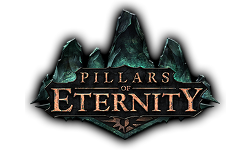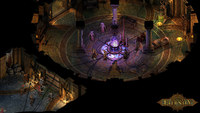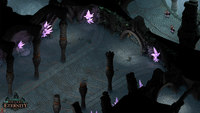|
|

|
PLATFORM
|
PC
|
BATTLE SYSTEM
|

|
INTERACTION
|

|
ORIGINALITY
|

|
STORY
|

|
MUSIC & SOUND
|

|
VISUALS
|

|
CHALLENGE
|
Adjustable
|
COMPLETION TIME
|
60-80 Hours
|
|
OVERALL

|
+ Great old-school 2.0 combat
+ Old classes with new tricks
+ Rich setting...
- That could be better presented at times
- Lack of character art
- Lack of voice over
|
Click here for scoring definitions
|
|
|
No one has thus far put a time machine up for crowdfunding, and given what movies have taught of the phenomenon I suspect that if time travel were invented it would never make it to consumer levels as its inventor would get caught in some sort of paradox-riddled shenanigans and recant the use of the device forever. But it seems that Obsidian has nonetheless managed to recover a game that 2002 forgot, Pillars of Eternity, a Kickstarter success story and a well put together game in the vein of the Infinity Engine titles of yore.
The story goes that long ago, the Ancient Wizards Whose Knowledge of Magic And Artifice Are Far Beyond Our Own™ waged a "holy" war to force all belief into their chosen deities and bind the souls of their worshipers into an eternal reincarnation cycle. One of these wizards, Thaos, has been using this cycle to further the schemes of his chosen goddess, which involves pulling the souls of an entire country to feed her more power. There's a lot of detailed lore that I'm glossing over, including an outlawed branch of magic, a team of wizards killing a god in the recent past and the current politics between empires, all of which find ways to creep into the action. The game walks a wobbly tightrope between adequate exposition and drowning the player in proper nouns, especially in the main story sections. The writing in these could benefit more from contextual cues and smoother exposition around these backstory elements. The plot of PoE itself is not so much a quest narrative as it is a thriller, with the player and assorted cronies chasing Thaos and his minions, unravelling a magical conspiracy and deciding the fate of big pile of unclaimed souls. The cat-and-mouse story format is a breath of fresh air in a genre busting at the seams with MacGuffin hunts and evil overlords.
From the player's side of the story, the game follows a mercenary newcomer to the Dyrwood region, who by coincidence is the reincarnation of the above wizard's right hand man, getting pulled back into Thaos' schemes after a supernatural storm as they gain the ability to see into the souls of others. In discovering the nature and cause of these new abilities the player unravels their and Thaos' shared past, and current conspiracies sends players on a massive adventure with large scale consequences. The standout element for the player character is that his or her past is as user-defined as their present. Dialogue options at the opening of the game, as well as in past-life flashback sections, offer the option to define backstory and past relations in a number of very interesting ways, including outright distortions of the truth by the player. It's rare for a game to offer players that degree of chalk on a blank slate character.
 Masked wizards in a circle - Never a good sign.
Masked wizards in a circle - Never a good sign.
|
|
Similar to the plot, the supporting cast defies convention as well; no golden-hearted thieves, wisecracking mercenaries, or naive apprentice mages to be found. Each character has a unique background, goals and a vibrant personality to match. NPCs, however, tend to fall short of the main cast. Most named NPCs are bolted in place to serve as exposition fonts, quest givers and the occasional dialogue-based roadblock. Minor NPCs seem to exist to fill space, not even adding colour to locale as the shuffle about the environments. There is also a new NPC type called the Kickstarter Backer — they have strange names highlighted in odd colours and when poked they'll spit out a drabble-length of soul viewing fiction. It is fun and intriguing the first few times, but by the last quest hub they become nothing but a pathfinding hindrance to all but the most dedicated lore-hounds.
The action of the game is where the comparisons to the millennial-era's D&D games like Baldur's Gate and Icewind Dale come into play. The user interface, the pause-and-play combat, even the dialogue window are all very specifically composed to bring the look at feel of those games to widescreen monitors of the modern gamer. This isn't to say there aren't improvements, as not only does it offer the chance to alter the pace of the action, speeding up backtracking through environments and slowing down for more tactical combat. There are also numerous conditions that can pause the game allowing better assessment of the situation, as well as actions for each character being queueable in advance granting a great deal more control of combat than those older titles.
Augmenting the new combat mechanics are a more imaginative array of character classes than the typical fantasy setting. Fighters, rogues, and wizards are joined by two other versatile classes. The first is the Cipher, a type of psionic warrior that builds up to special attacks throughout combat. The other is the Chanter, a sort of bard who blends a playlist of different buff effects with magical summons and a solid second rank fighting ability. The mainstays of the genre have also taken on new flavours in this game, like monks who must take some hits before they can dish out special moves, or fighters whose talent trees help them progress beyond the basic thumping of monsters.
 Pictured: many of the games completely temporal pillars.
Pictured: many of the games completely temporal pillars.
|
|
Art quality is a divided matter. The characters are three dimensional models that look very nice with enough detail at high resolution and high levels of zoom to keep characters looking distinct. The two-dimensional backgrounds, while well-drawn and vibrant, they do develop notable jaggy-ness upon close inspection. Pillars' music is adequate, not especially memorable neither catchy nor grating. On the other side of the audio equation the voice acting is wonderful and adds to the well drawn nature of the characters. But there isn't enough of either, the beginnings of conversations with major NPCs and party members are voiced, but as the exchange continues and the tree gets broader the voices stop. There is a good budgetary reason for this, but it takes some punch out of the more dramatic conclusions of dialogue, also only the party and the main antagonist get character portraits, which loses some of the personality for major supporting characters.
This game exists solely because of nostalgia goggles intersecting with crowdfunders' wallets. As a throwback it successfully evokes the best sensations of a ten-year-old style of game while making a few modern improvements and leaving the worst the genres old hindrances behind. It's also worth noting as the first Obsidian where game I haven't encountered a single glitch during play. Pillars is a title that should make old-schoolers happy while still offering a solid core game, story, and a rich setting for new-schoolers.
Review Archives
|









